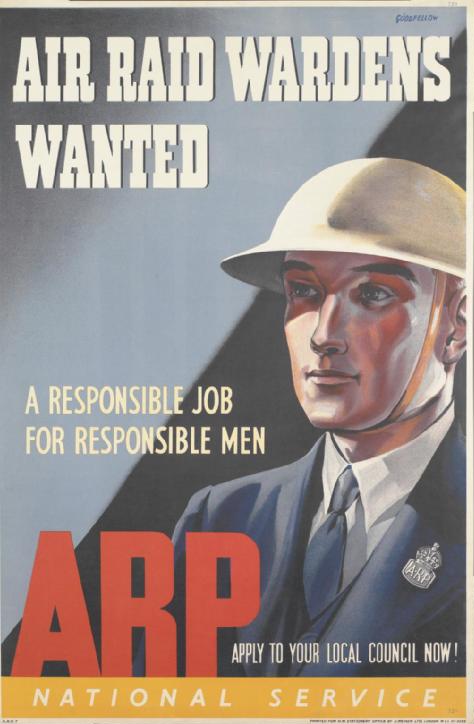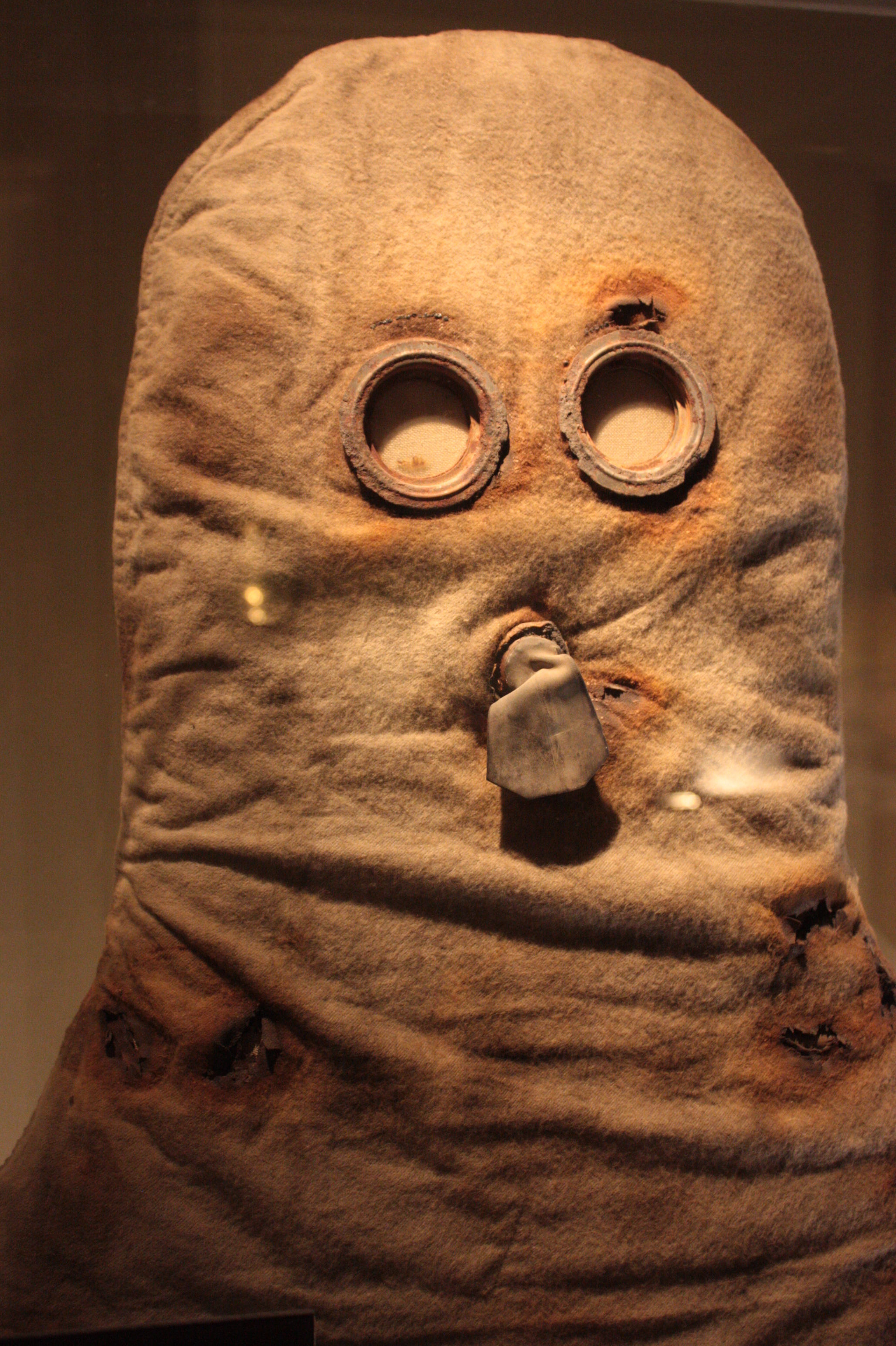|
Civil Defence Service
The Civil Defence Service was a civilian volunteer organisation in Great Britain during World War II. Established by the Home Office in 1935 as Air Raid Precautions (ARP), its name was officially changed to the Civil Defence Service (CD) in 1941. The Civil Defence Service included the ARP Wardens Service as well as firemen (initially the Auxiliary Fire Service (AFS) and latterly the National Fire Service (NFS)), fire watchers (later the Fire Guard), rescue, first aid post and stretcher parties. Over 1.9 million people served within the CD and nearly 2,400 lost their lives to enemy action. Organisation The organisation of civil defence was the responsibility of each local authority. Volunteers were ascribed to different units depending on experience or training. Each local civil defence service was divided into several sections. *Wardens were responsible for local reconnaissance and reporting, and leadership, organisation, guidance and control of the general public. Wardens would ... [...More Info...] [...Related Items...] OR: [Wikipedia] [Google] [Baidu] |
Civil Defence Service Flag
{{disambiguation ...
Civil may refer to: *Civic virtue, or civility *Civil action, or lawsuit * Civil affairs *Civil and political rights *Civil disobedience *Civil engineering *Civil (journalism), a platform for independent journalism *Civilian, someone not a member of armed forces *Civil law (other), multiple meanings * Civil liberties *Civil religion *Civil service *Civil society *Civil war *Civil (surname) Civil is a surname. Notable people with the surname include: *Alan Civil (1929–1989), British horn player *François Civil (born 1989), French actor * Gabrielle Civil, American performance artist * Karen Civil (born 1984), American social media a ... [...More Info...] [...Related Items...] OR: [Wikipedia] [Google] [Baidu] |
Air Raid Precautions
Air Raid Precautions (ARP) refers to a number of organisations and guidelines in the United Kingdom dedicated to the protection of civilians from the danger of air raids. Government consideration for air raid precautions increased in the 1920s and 30s, with the Raid Wardens' Service set up in 1937 to report on bombing incidents. Every local council was responsible for organising ARP wardens, messengers, ambulance drivers, rescue parties, and liaison with police and fire brigades. From 1 September 1939, ARP wardens enforced the " blackout". Heavy curtains and shutters were required on all private residences, commercial premises, and factories to prevent light escaping and so making them a possible marker for enemy bombers to locate their targets. With increased enemy bombing during the Blitz, the ARP services were central in reporting and dealing with bombing incidents. They managed the air raid sirens and ensured people were directed to shelters. Women were involved in ARP serv ... [...More Info...] [...Related Items...] OR: [Wikipedia] [Google] [Baidu] |
Civil Defence Corps
The Civil Defence Corps (CDC) was a civilian volunteer organisation established in Great Britain in 1949 to mobilise and take local control of the affected area in the aftermath of a major national emergency, principally envisaged as being a Cold War nuclear attack. By March 1956, the Civil Defence Corps had 330,000 personnel."A Brief History of Civil Defence", Tim Essex-Lopresto, Civil Defence Association, , 2005 It was stood down in Great Britain in 1968, although two Civil Defence Corps still operate within the British Isles, namely the Isle of Man Civil Defence Corps and the unrelated Civil Defence Ireland in the Republic of Ireland. Many other countries maintain a national Civil Defence Corps, usually having a wide brief for assisting in large scale civil emergencies such as flood, earthquake, invasion, or civil disorder. The unit has now been re-established. The Joint Civil Aid Corps – a voluntary Civil Defence (Emergency Support) organisation. Its concept is to provide ... [...More Info...] [...Related Items...] OR: [Wikipedia] [Google] [Baidu] |
Hyde Park, London
Hyde Park is a Grade I-listed major park in Westminster, Greater London, the largest of the four Royal Parks that form a chain from the entrance to Kensington Palace through Kensington Gardens and Hyde Park, via Hyde Park Corner and Green Park past the main entrance to Buckingham Palace. The park is divided by the Serpentine and the Long Water lakes. The park was established by Henry VIII in 1536 when he took the land from Westminster Abbey and used it as a hunting ground. It opened to the public in 1637 and quickly became popular, particularly for May Day parades. Major improvements occurred in the early 18th century under the direction of Queen Caroline. Several duels took place in Hyde Park during this time, often involving members of the nobility. The Great Exhibition of 1851 was held in the park, for which The Crystal Palace, designed by Joseph Paxton, was erected. Free speech and demonstrations have been a key feature of Hyde Park since the 19th century. ... [...More Info...] [...Related Items...] OR: [Wikipedia] [Google] [Baidu] |
George VI
George VI (Albert Frederick Arthur George; 14 December 1895 – 6 February 1952) was King of the United Kingdom and the Dominions of the British Commonwealth from 11 December 1936 until his death in 1952. He was also the last Emperor of India from 1936 until the British Raj was dissolved in August 1947, and the first Head of the Commonwealth following the London Declaration of 1949. The future George VI was born in the reign of his great-grandmother Queen Victoria; he was named Albert at birth after his great-grandfather Albert, Prince Consort, and was known as "Bertie" to his family and close friends. His father ascended the throne as George V in 1910. As the second son of the king, Albert was not expected to inherit the throne. He spent his early life in the shadow of his elder brother, Prince Edward, the heir apparent. Albert attended naval college as a teenager and served in the Royal Navy and Royal Air Force during the First World War. In 1920, he was made ... [...More Info...] [...Related Items...] OR: [Wikipedia] [Google] [Baidu] |
Civil Defence Speech
{{disambiguation ...
Civil may refer to: *Civic virtue, or civility *Civil action, or lawsuit * Civil affairs *Civil and political rights *Civil disobedience *Civil engineering *Civil (journalism), a platform for independent journalism *Civilian, someone not a member of armed forces *Civil law (other), multiple meanings * Civil liberties *Civil religion *Civil service *Civil society *Civil war *Civil (surname) Civil is a surname. Notable people with the surname include: *Alan Civil (1929–1989), British horn player *François Civil (born 1989), French actor * Gabrielle Civil, American performance artist * Karen Civil (born 1984), American social media a ... [...More Info...] [...Related Items...] OR: [Wikipedia] [Google] [Baidu] |
Zuckerman Helmet
The Zuckerman helmet, officially designated the Civilian Protective Helmet, was a British helmet designed for use by civil defence organisations and the general public during World War II. It was researched and designed by Solly Zuckerman, Derman Christopherson and Hugh Cairns. Background Zuckerman and Cairns first started looking into a design for a helmet to aid civil defence in the mid-1940. Their aim was to provide a helmet that could deal with impact from falling and flying masonry and provide more coverage for the head and the neck areas. After the War Office accepted their design, the ''Civilian Protective Helmet'' went into circulation in December 1940 and throughout 1941, the vast majority therefore being dated 1941. Production Helmets were made from pressed mild steel or manganese steel (known for its impact resistance) in two sizes only and sometimes marked with either M (medium) or L (large) on the inside of the brim. The design of the high dome was to allow the h ... [...More Info...] [...Related Items...] OR: [Wikipedia] [Google] [Baidu] |
Brodie Helmet
The Brodie helmet is a steel combat helmet designed and patented in London in 1915 by Latvian inventor John Leopold Brodie ( lv, Leopolds Janno Braude). A modified form of it became the Helmet, Steel, Mark I in Britain and the M1917 Helmet in the US. Colloquially, it was called the shrapnel helmet, battle bowler, Tommy helmet, tin hat, and in the United States the doughboy helmet. It was also known as the dishpan hat, tin pan hat, washbasin and Kelly helmet. The German Army called it the ''Salatschüssel'' (salad bowl). The term ''Brodie'' is often misused. It is correctly applied only to the original 1915 ''Brodie's Steel Helmet, War Office Pattern''. Background At the outbreak of World War I, none of the combatants provided steel helmets to their troops. Soldiers of most nations went into battle wearing cloth, felt, or leather headgear that offered no protection from modern weapons. The huge number of lethal head wounds that modern artillery weapons inflicted upon the French ... [...More Info...] [...Related Items...] OR: [Wikipedia] [Google] [Baidu] |
Gas Mask
A gas mask is a mask used to protect the wearer from inhaling airborne pollutants and toxic gases. The mask forms a sealed cover over the nose and mouth, but may also cover the eyes and other vulnerable soft tissues of the face. Most gas masks are also respirators, though the word ''gas mask'' is often used to refer to military equipment (such as a field protective mask), the scope used in this article. The gas mask only protects the user from digesting, inhaling, and contact through the eyes (many agents affect through eye contact). Most combined gas mask filters will last around 8 hours in a biological or chemical situation. Filters against specific chemical agents can last up to 20 hours. Airborne toxic materials may be gaseous (for example, chlorine or mustard gas), or particulates (such as biological agents). Many filters provide protection from both types. The first gas masks mostly used circular lenses made of glass, mica or cellulose acetate to allow vision. Glass ... [...More Info...] [...Related Items...] OR: [Wikipedia] [Google] [Baidu] |
Air Raid Precautions Warden's Helmet, Museum Of Liverpool
The atmosphere of Earth is the layer of gases, known collectively as air, retained by Earth's gravity that surrounds the planet and forms its planetary atmosphere. The atmosphere of Earth protects life on Earth by creating pressure allowing for liquid water to exist on the Earth's surface, absorbing ultraviolet solar radiation, warming the surface through heat retention (greenhouse effect), and reducing temperature extremes between day and night (the diurnal temperature variation). By mole fraction (i.e., by number of molecules), dry air contains 78.08% nitrogen, 20.95% oxygen, 0.93% argon, 0.04% carbon dioxide, and small amounts of other gases. Air also contains a variable amount of water vapor, on average around 1% at sea level, and 0.4% over the entire atmosphere. Air composition, temperature, and atmospheric pressure vary with altitude. Within the atmosphere, air suitable for use in photosynthesis by terrestrial plants and breathing of terrestrial animals is found only in Ea ... [...More Info...] [...Related Items...] OR: [Wikipedia] [Google] [Baidu] |






